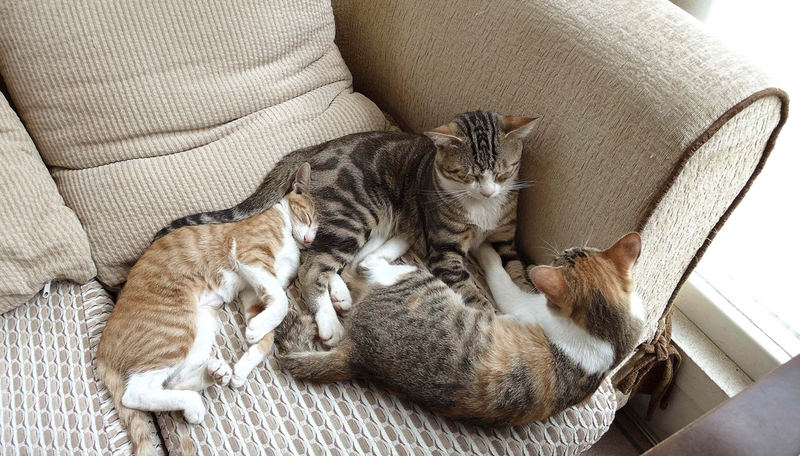Are you feeling worried and even scared because your beloved kitten has just thrown up a bunch of white foam? Is she sick? Is there something else you need to know about her? Is it because she's eating too much of raw food or is feeding on your houseplants? Stop panicking – cat throwing up white foam is common, but let's find out if you should do something about it or the issue will resolve on its own.

Why Does Your Cat Throwing Up with White Foam?
Overeating
Kittens can sometimes overeat and this may lead to certain problems. If you have a young kitten at home with no clue about when to stop eating, you may soon see a cat vomiting foam.
Dietary Changes
If you change your kitten's diet suddenly, this may also lead to vomiting. It is therefore important that you take some time and introduce new foods slowly to ensure your kitten faces no stomach related issues.
Skipping Meal
It could be that she has not received enough food and her stomach is still empty. A cat's stomach will release gastric juices, bile, and hydrochloric acid to create a feasible environment to digest food. If you don't feed your cat for long, the buildup of hydrochloric acid may cause stomach irritation. This may result in your cat throwing up white foam – it may also be a combination of white foam and yellowish bile.
Sign of Hairballs
You may have a cat throwing up foam due to hairballs. Many cats swallow hair and vomit foam as a result. This is usually the case when your cat makes noticeable hacking sounds. Sometimes, the mass may also form a plug that strains liquid out and looks like foam. Reduced appetite and constipation are other common indications of hairballs.
Enteritis
In this condition, the small intestine of some kittens becomes inflamed. Some of the most common symptoms of enteritis are weight loss, lack of energy, diarrhea, and vomiting. The vomiting may include bile, blood, or food, but it usually has a white foamy consistency.
Inflammatory Bowel Disease
Your cat may be suffering from a disease called inflammatory bowel disease or IBD. This can cause a variety of stomach and gastrointestinal problems in kitten. You will see your cat throwing up white foam if unwanted cells have invaded the gastrointestinal tract. Other symptoms of IBD are lack of energy, weight loss, diarrhea, and loss of appetite.
Adrenal Gland Disease
Some kittens suffer from adrenal gland disease in which they cannot produce enough cortisone. This often leads to vomiting of a foaming white substance. The disease can affect both mature and young cats. Female kittens are more at risk. Some of the most common symptoms of adrenal gland disease include low blood sugar, diarrhea, muscle weakness, depression, and lethargy.
What to Do If Your Cat Throw Up the White Foam?
Fasting
If your cat is throwing up white foam, you may consider fasting as a way to resolve the issue. A 24-hour fast will do the job in most cases. The idea is to give your cat's stomach some rest to reduce inflammation. Just be sure to provide them with enough water throughout the day. After 24 hours, start with bland foods such as cooked white rice and give her regular food after 48 hours. Stick to the bland diet if the condition doesn't improve much after 72 hours.
Peppermint Tea
Peppermint tea helps settle upset stomach – it works great for human and is equally effective for your kittens. Simply brew a cup of peppermint tea and let it cool off for some time. Give her a tablespoon after regular intervals to soothe her tummy.
Hairball Relief
Since you cannot stop cats from licking their fur, it is common to see them dealing with hairballs. It is important to do something for hairball relief because if your cat digests it, she may have constipation. The best thing is to give your cat a teaspoon of mineral oil thrice a week – you can simply add it to their regular food. It works as a laxative and helps prevent constipation and vomiting.
When to Call a Veterinarian If My Cat Is Throwing Up White Foam
If you see your cat throwing up white foam and you have tried other remedies, you may consider paying a visit to her veterinarian. Here are a few points to help you decide if it is time to call a veterinarian.
Notice your cat's appetite. If she is not interested in eating, it usually means something's bothering her. It could also be due to a serious condition called fatty liver.
Check the frequency of vomiting. If your cat's vomiting a couple of times a day, there's no need to worry about it. It should be a cause of concern if she's vomiting several times an hour.
Observe how thirsty your cat is. If you notice a considerable increase in her thirst after vomiting, this could be due to kidney toxicity.
Examine urination habits. This is especially important when you have a male cat that's vomiting and facing issues when urinating. This may be due to a urinary tract blockage.
In addition to all this, you should trust your gut feeling. If your cat is not behaving like he/she always does, it is a good idea to take him/her to a veterinarian.

View All Comments /Add Comment